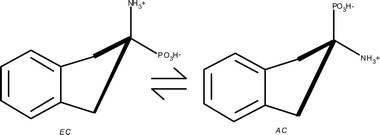Experimental and ab initio calculated structures of 2-aminoindane-2-phosphonic acid, a potent inhibitor of phenylalanine ammonia-lyase, and theoretical studies of its binding to the model enzyme structure†
Abstract
The structure of

Maintenance work is planned for Wednesday 1st May 2024 from 9:00am to 11:00am (BST).
During this time, the performance of our website may be affected - searches may run slowly and some pages may be temporarily unavailable. If this happens, please try refreshing your web browser or try waiting two to three minutes before trying again.
We apologise for any inconvenience this might cause and thank you for your patience.
* Corresponding authors
a
Institute of Organic Chemistry Biochemistry and Biotechnology, Wrocław University of Technology, Wybrzeże Wyspiańskiego 27, Wrocław, Poland
E-mail:
jerzy.zon@pwr.wroc.pl
Fax: +48 71 328 4064
Tel: +48 71 320 3260
b Institute of Physical and Theoretical Chemistry, Wrocław University of Technology, Wybrzeże Wyspiańskiego 27, Wrocław, Poland
c Faculty of Chemistry, University of Wrocław, St. F. Joliot-Curie 14, Wrocław, Poland
d Institute of Inorganic Chemistry and Metallurgy of Rare Elements, Wrocław University of Technology, Wybrzeże Wyspiańskiego 27, Wrocław, Poland
e Institute of Plant Sciences, Federal Institute of Technology Zürich, Zürich, Switzerland
The structure of

 Please wait while we load your content...
Something went wrong. Try again?
Please wait while we load your content...
Something went wrong. Try again?
J. Zoń, B. Szefczyk, W. Sawka-Dobrowolska, R. Gancarz, M. Kucharska-Zoń, R. Latajka, N. Amrhein, P. Miziak and W. Szczepanik, New J. Chem., 2004, 28, 1048 DOI: 10.1039/B307533H
To request permission to reproduce material from this article, please go to the Copyright Clearance Center request page.
If you are an author contributing to an RSC publication, you do not need to request permission provided correct acknowledgement is given.
If you are the author of this article, you do not need to request permission to reproduce figures and diagrams provided correct acknowledgement is given. If you want to reproduce the whole article in a third-party publication (excluding your thesis/dissertation for which permission is not required) please go to the Copyright Clearance Center request page.
Read more about how to correctly acknowledge RSC content.
 Fetching data from CrossRef.
Fetching data from CrossRef.
This may take some time to load.
Loading related content
